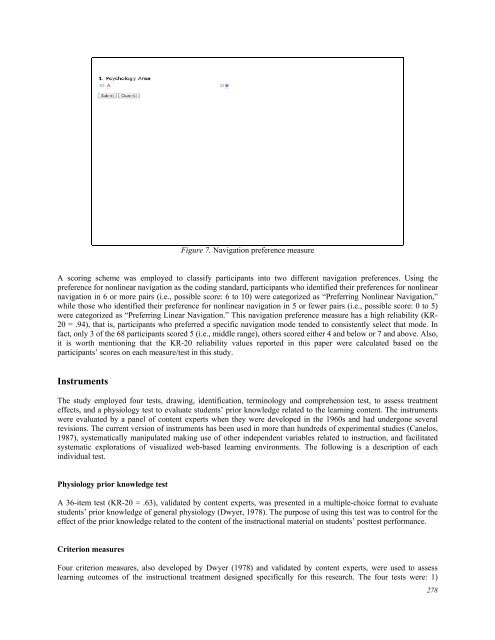The effects of web-based instruction navigation modes - Educational ...
The effects of web-based instruction navigation modes - Educational ...
The effects of web-based instruction navigation modes - Educational ...
Create successful ePaper yourself
Turn your PDF publications into a flip-book with our unique Google optimized e-Paper software.
Figure 7. Navigation preference measure<br />
A scoring scheme was employed to classify participants into two different <strong>navigation</strong> preferences. Using the<br />
preference for nonlinear <strong>navigation</strong> as the coding standard, participants who identified their preferences for nonlinear<br />
<strong>navigation</strong> in 6 or more pairs (i.e., possible score: 6 to 10) were categorized as “Preferring Nonlinear Navigation,”<br />
while those who identified their preference for nonlinear <strong>navigation</strong> in 5 or fewer pairs (i.e., possible score: 0 to 5)<br />
were categorized as “Preferring Linear Navigation.” This <strong>navigation</strong> preference measure has a high reliability (KR-<br />
20 = .94), that is, participants who preferred a specific <strong>navigation</strong> mode tended to consistently select that mode. In<br />
fact, only 3 <strong>of</strong> the 68 participants scored 5 (i.e., middle range), others scored either 4 and below or 7 and above. Also,<br />
it is worth mentioning that the KR-20 reliability values reported in this paper were calculated <strong>based</strong> on the<br />
participants’ scores on each measure/test in this study.<br />
Instruments<br />
<strong>The</strong> study employed four tests, drawing, identification, terminology and comprehension test, to assess treatment<br />
<strong>effects</strong>, and a physiology test to evaluate students’ prior knowledge related to the learning content. <strong>The</strong> instruments<br />
were evaluated by a panel <strong>of</strong> content experts when they were developed in the 1960s and had undergone several<br />
revisions. <strong>The</strong> current version <strong>of</strong> instruments has been used in more than hundreds <strong>of</strong> experimental studies (Canelos,<br />
1987), systematically manipulated making use <strong>of</strong> other independent variables related to <strong>instruction</strong>, and facilitated<br />
systematic explorations <strong>of</strong> visualized <strong>web</strong>-<strong>based</strong> learning environments. <strong>The</strong> following is a description <strong>of</strong> each<br />
individual test.<br />
Physiology prior knowledge test<br />
A 36-item test (KR-20 = .63), validated by content experts, was presented in a multiple-choice format to evaluate<br />
students’ prior knowledge <strong>of</strong> general physiology (Dwyer, 1978). <strong>The</strong> purpose <strong>of</strong> using this test was to control for the<br />
effect <strong>of</strong> the prior knowledge related to the content <strong>of</strong> the <strong>instruction</strong>al material on students’ posttest performance.<br />
Criterion measures<br />
Four criterion measures, also developed by Dwyer (1978) and validated by content experts, were used to assess<br />
learning outcomes <strong>of</strong> the <strong>instruction</strong>al treatment designed specifically for this research. <strong>The</strong> four tests were: 1)<br />
278
















